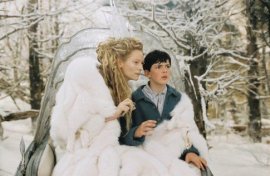 THE CHRONICLES OF NARNIA: THE LION, THE WITCH, & THE WARDROBE
THE CHRONICLES OF NARNIA: THE LION, THE WITCH, & THE WARDROBE
The Chronicles of Narnia: The Lion, the Witch, & the Wardrobe, director Andrew Adamson's imagining of the first book in C. S. Lewis' Narnia series, is almost childishly clunky, but it's nearly impossible to dislike. Geared, as it appears, toward a very young audience - I'd say seven or eight - the movie is sweet, and it's sincere, and it displays a welcome touch of fairy-tale simplicity. Despite the rather prosaic nature of its presentation, Narnia is one of those movies that, if it catches children at the right age, might linger in their memories for some time to come; it's just magical enough to suggest how magical it should have been. For kids who are finally seeing their beloved Narnia novel translated to the big screen, Adamson's Narnia will be good enough. It just doesn't have much to offer the rest of us. Adamson is co-director of the Shrek movies, and he does a fair enough job with the movie's CGI wonders; the lion Messiah Aslan (voiced, to the surprise of no one, by Liam Neeson) moves with regal grace, and the beavers who accompany the Pevensie children on their quest seem to be, for kids in the audience, enjoyably frisky characters. But all throughout the film, I had the nagging feeling that, if he was allowed, Adamson would have happily computer-generated his humans, too.